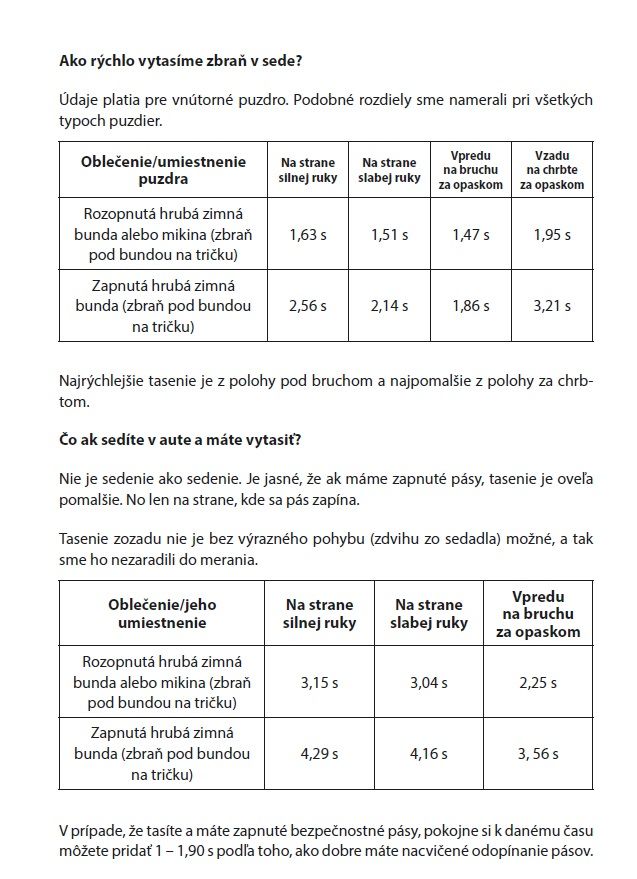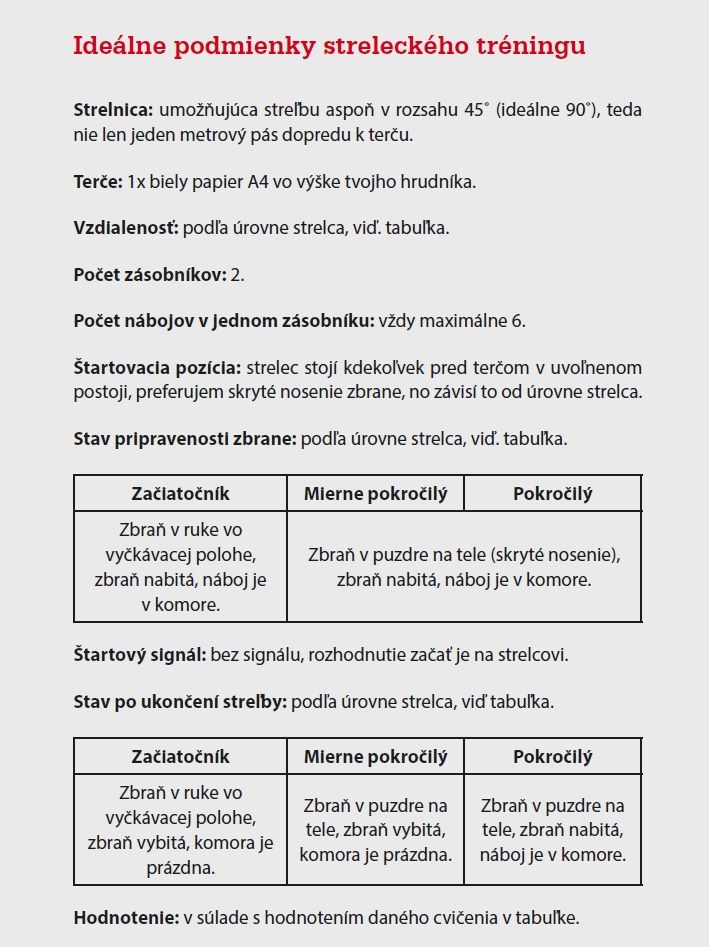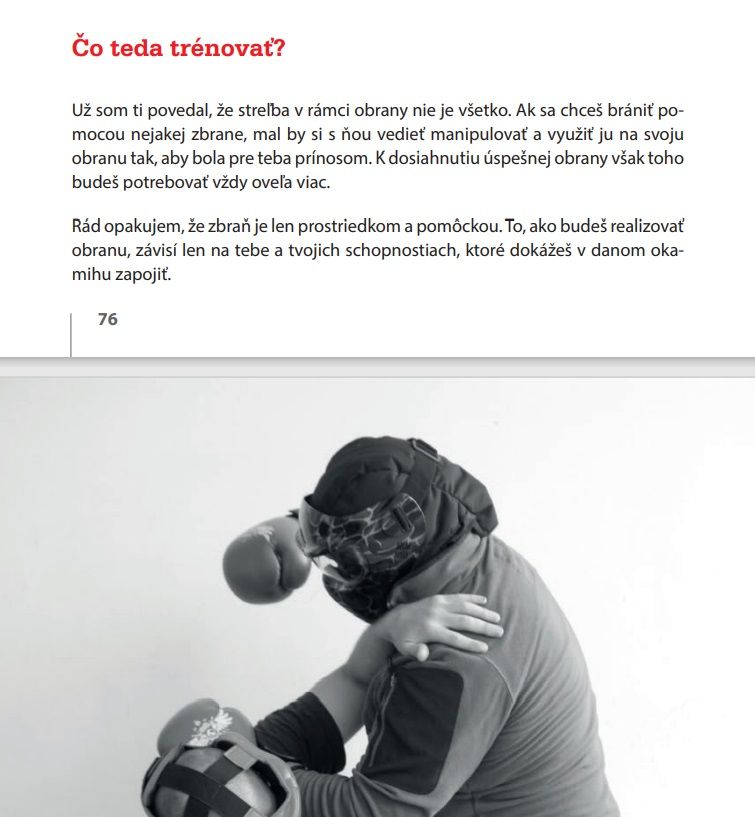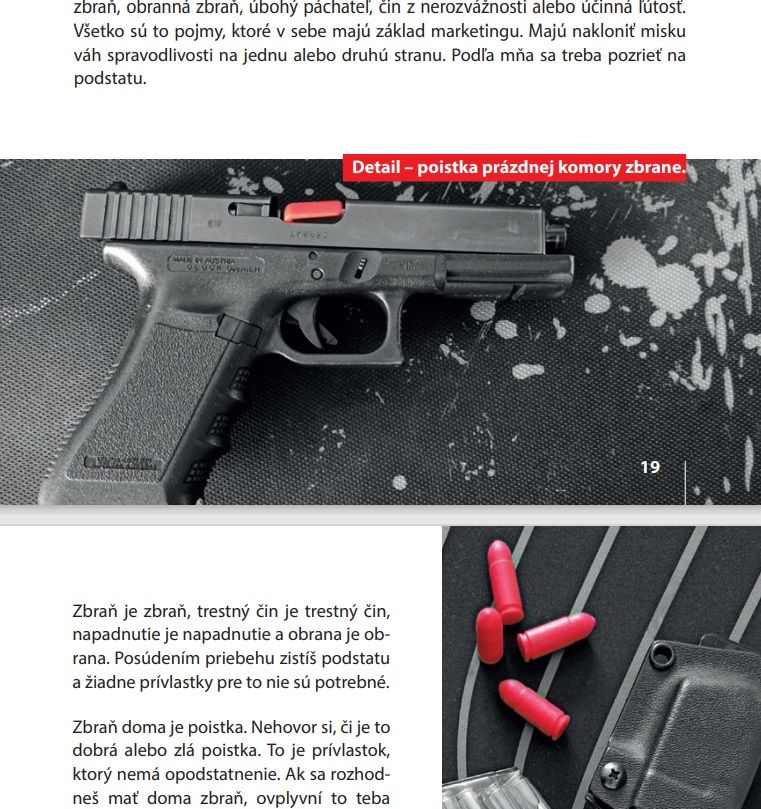It is a well-known fact that people spend a lot of money on ammunition, shooting range rental, equipment, clothing, but their shooting skills stagnate or showmany flawed techniques and unrealistic elements.
They are not interested in the basic defense principles or efficiency, but only in some good feeling they may have when hitting the target at 5 meters in nonviolent conditionsor when they “dress up in combat gear” and take a few photos.
Despite this, the use of a weapon in real defense is completely different from what they practice.
How to defend oneself with a gun?
I wrote a practical guide for the reader to understand real gundefense, the approach to training, including instruction and tips on what to watch out for.
I published the book in Slovakia with many positive reviews. Hence, I would like to publish it in English for all who are interested in gun defense and would like to read about a different understanding of defense as opposed to the standard one.
Understandably, professional translation and publication of the book are financially challenging, so I decided to do a little survey to see if there would be any interest in the book.
So, welcome to this website and feel free to read a sample from my book HOW TO TRAIN DEFENSIVE SHOOTING and judge for yourself whether you would be interested.
Read on and share with me your opinion and whether you would be interested in this book.
Patrik
Introduction
Becoming a shooting instructor was never my ambition; I became one out of necessity.
During my 20 years of experience in the military, I experienced many meaningful and special courses on shooting, tactics and other areas. These have focused on police and military procedures as well as on convoy tactics and escorting and protecting people. However, I was always in the position of both having to and wanting to learn these skills in order to be able to use it myself if needed.
We were taught by many excellent foreign instructors from various specialized units or rifle academies. For example, from Israel, USA, Germany, Austria, and Hungary as well as from Slovakia and Czechia. They showed us their systems and shooting tactics, which always featured something novel, unique or proven in practice.
Although I eventually concluded my military career as Chief of Instructors and Director of the Special Training Department of the Lest Training Center, I always tended to focus on the areas of survival, psychology of training, captivity and climbing activities where I found much more creativity and measurable results because the field of close combat and marksmanship always had elements of distorted situations and alleviated conditions.
In order to keep in practice and in touch with people in the field after I left the Army, I started practicing IPSC (International Practical Shooting Confederation) sport shooting. I took shooting courses and became interested in defensive shooting from the point of view of an ordinary citizen.
Even then there were, and are now, many companies or instructors practicing this at a very good level. And it's great that there are many people who own guns and want to learn how to defend themselves while handling the gun safely.
However, I ran into a problem that caused me to start looking deeper into defensive shooting and I dropped sport shooting altogether. It consisted of a different perspective on defending yourself with a gun. Everyone would look at it from their own point of view. But no one did that from the perspective of actually carrying a gun and defending oneself“on the street”.
What were these different perceptions?
Sport shooters focused on their defense using measurable values (strength, speed, accuracy, dynamics, and tactics with greatest efficiency and shortest time) to be able to compare themselves under competition. They had their established rules and shooting situations that forced them to solve the self-defense situation by quickly drawing their weapon and proceeding dynamically without thinking about their own safety.
The second group of defensive or practical shooters, focused on shooting skills in accordance with tactics, to solve a self-defense situation, as I call it, by a preventive procedure. That is, by drawing the weapon prior to an attack, before an immediate threat arises, and then dealing with the situation by shooting, they would enter a threatened area, fighting for it.
I call the last group combat shooters. It is made up mostly of former members of the armed forces (military and police) who recognize a situation purely professionally in terms of skills and knowledge. They learned these in the armed forces and transformed them into so-called defense-combat shooting.
The problem was that even though I was taking courses, visiting other instructors who were showing me their defensive shooting system, I still felt it wasn't quite right; something was missing for me. Each one of the instructors was good at something and they favored that. However their overall concept of defense was based on assumptions.
I always understood that each one of them had a history that predisposed the way they acquired their shooting skills. That is why they would focus on defense specifically through the techniques and principles they learned in the force, whether military or police, or as a sport shooter.
However, overall trends tend to lean towards erroneous or incomplete principles of armed defense. That would maybe work for them based on abundant diverse training and practice and using their weapon in sporting or professional activities. For this reason, I began to look at defensive shooting from the perspective of tests and various measurements. I have extensively dealt with simulations of various types of assaults, their progression and implementation.
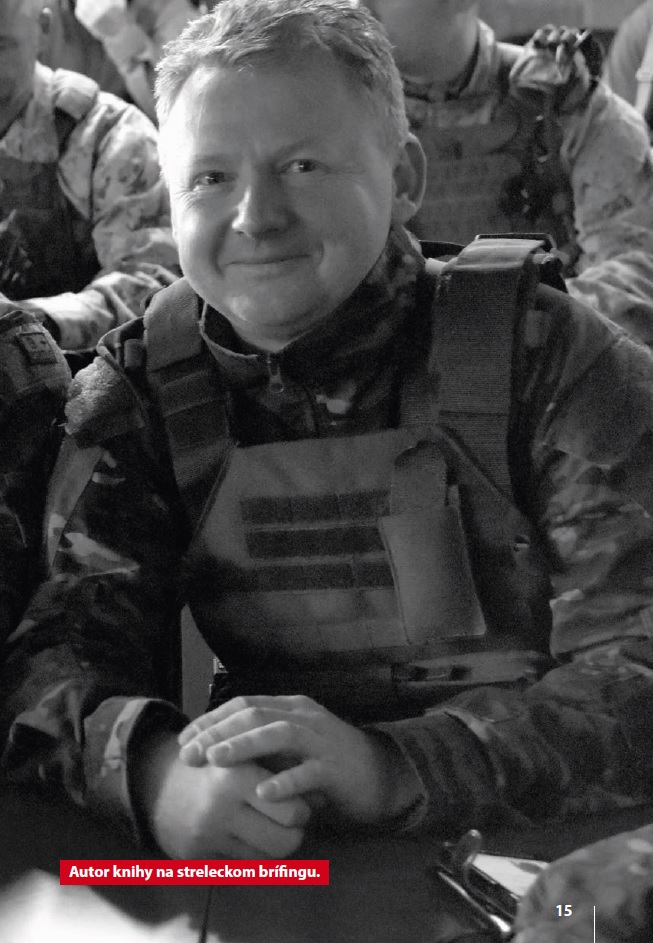
The author at a shooting briefing.
In these situations all the weaknesses of the military and police approach, or the negatives of the sporting solution, became apparent. Accuracy did not play any significant advantage at the beginning of the encounter.On the contrary, the defender's psyche and set-up played a big role as didaggressivity and movement. What I had mastered from the military and other shooting I called “professional weapon use". In practice, however, it no longer worked and it frustrated me.
PLEASE NOTE THAT WE ARE DISCUSSING USE OF A WEAPON FOR SELF-DEFENSE IN ACCORDANCE WITH OUR LEGAL STANDARDS AND REGULATIONS. THESE CLEARLY STIPULATE UNDER WHAT CONDITIONS YOU CAN USE YOUR WEAPON TO DEFEND YOURSELF.
I realized that defense on the street, with or without a firearm, is based on very different principles of combat:under different time and distance considerations and with diverse equipment.
This understanding led me to answers that changed my view of armed defense. The simulations clearly showed what really works and what is only a hypothesis. What really needs to be trained and what is completely unnecessary. I also determined what is awaste of time. It showed me how I should be mentally and tactically prepared and how I should be physically and materially equipped.
But beware!
The first prerequisite for understanding the basic principle of defense - with or without a weapon - in a truly aggressive attack on me is the fact that I only have a 50% chance of defending myself or surviving. If the attack is really surprising, aggressive and strong, I have no chance. I could be a world champion or an excellent instructor of shooting and hand-to-hand combat but I am unable to defend myself.
The second essential understanding for defense is the fact that prevention is the best solution. Paying attention to details, listening to your gut feeling for the threat, following safety procedures and everything else that goes with this. It is better to see and react early enough rather than being surprised and having no chance.
This leaves the defender with only 50% remaining to survive. If I can spot the attack in time, or expect it, I can survive by reacting appropriately. And that's what it's all about in the end. Saving a life is the most important thing I should always think about. Not holding a gun and going to win a fight.
This, in my opinion, is the biggest flaw in most of the shooting defense systems I have seen and attended so far.
If I get a second chance in life, I have time to defend myself and respond to an attack. I should do it in a way that my defense leads to that goal. In my training, I want to focus on the techniques, drills, and mental preparation that give me the best chance of saving my life.
And the result?
I have summarized all my findings from testing and simulations, put them into a simple, coherent system in which I start with the basic principles of defense in an open area and continue with defense in rooms, apartments or offices, and end with defense on the street or in the car.
I call this system Individual Self-Defense Shooting (ISDS).
It is based on the primary defense of an individual in daily life. It is essentially a philosophy of total defense against attack and is influenced by martial arts, safety approaches and prevention in everyday life.
The purpose of this system is to implement defense based on natural, simple and intuitive reactions. It utilizes easy yet effective techniques. It adapts to the situation and environment. It is a mind-set that leads to an immediate reaction, moving out of the attack zone and advancing to deflect the attack.
I will introduce you to this system in this book. In addition, I try to respond to any controversial views, at least from my perspective. I acquired this approach through numerous simulations, measurements and tests that my assistants and I carried out at the shooting range or in the gym.
Please note, however, that this is solely my view of defending oneself with a gun. And my goal is not to convince or force anyone to do anything differently.
My goal is to inspire. Just as everything around us is evolving and advancing, this field should not stagnate. With new technical means, ammunition, weapons, training methods and support systems from various training simulations, this field of self defense should progress. Progress so that graduates of similar training, when under threat or attack, can increase their chance of survival to the maximum.


EXPOSING THE BIGGEST ENEMIES OF DEFENSE SHOOTING
Defense shooting has one specific element that everyone knowsbut ignores during their training, which is a big mistake.
It is the element of surprise.
You can build a so-called secret parkour at the shooting range, which will only be visible as you enter the shooting area. But in principle that's not the same as what happens in a real-life situation. It's not the same for execution of a defense and for your psyche.
At the shooting range you're prepared for it and you expect something to happen. That's why your approach at the shooting range will be completely different than in a surprise attack. I don't want to go into too much detail in this chapter about the different types of simulations, their goals, or their actual timing and execution factors. That will be clarified later.
Based on our simulations with an active attacker under various training procedures, which we measured and evaluated, I have specified problem areas and details that had a negative impact on defense. Defending with them present was completely different or required a different approach as the given shooters were trained in the simulations.
Unfortunately, I have encountered these elements on a regular basis in shooting courses or in recommended videos. I'm not saying that these practices or shooting techniques are badbut I think they considrably narrow down the options for defense. They are only for situations where you can anticipate and prepare for a certain attacker's advance. But in reality, it works quite differently. And so, you're preparing for something that may not actually occur. When defending yourself, you have to adapt and react to what is really happening and not to what you assume is happening. In my opinion, training based on assumptions does not prepare you for reality.
Let's discuss shooting elements and procedures. It is mainly aboutfeeling that:
- you expect the attack, you will be ready for it and you're going to solve it with precision marksmanship,
- you'll know the exact moment to use your weapon to defend yourself,
- all you need to do to defend yourself effectively is to handle the weapon and hit the target,
- you'll have time to get into a shooting stance when you're defending yourself,
- have the ability to grip the weapon and shoot with both hands,
- you will have time to load or reload the weapon during the self-defense reaction,
- drawing and firing speed are paramount to effective defense,
- you will be mentally at ease when defending yourself and you will use
- what instructors taught you at the range,
- you'll be as accurate when shooting at an attacker as you are when shooting at a target,
- you'll have time to get your bearings, evaluate the situation, and figure out where you're going to hit the attacker,
- you'll use your weapon to defend yourself at a distance of more than three meters.
I say the biggest mistake in defensive shooting is adapting your defensive procedures to any assumptions about the defender's course of attack or the actual shooting to hit the attacker. From my point of view defense with a weapon is only one possibility in the total range of all other contingencies.
In self defense, I have to apply everything I am capable of using at the time. If I can escape, my first priority is to save my life and not to shoot. That's why I'm advocating this opinion borne out by my experience in simulations. Shooting must adapt to use of defensive procedures,not the other way around where defense adapts to shooting procedures. This is also important from an overall perspective of training methodology and preparation for defensive situations.
Aquestion needs to be asked: Am I going to rely on only one defensive option in a crisis situation or will I use all available options to resolve the situation? Think about it...
If you practice shooting, and only shooting for your defense, then you are relying on this as the only possible solution. That's very bad.
From my perspective, these faulty shooting practices are ingrained for the very reason that in defensive shooting drillsthe most attention is paid to shooting and not to defense.
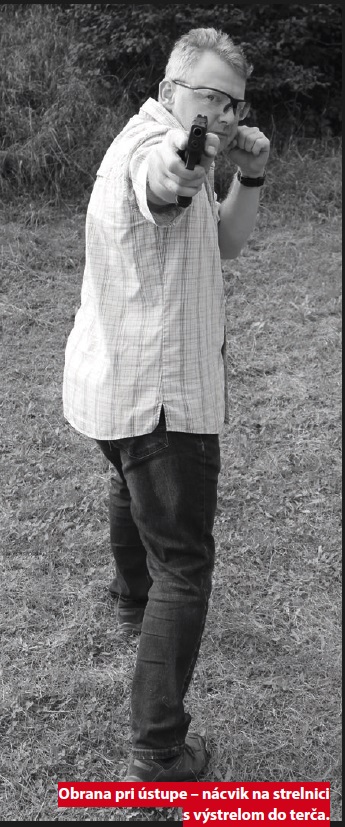
Defense while retreating – training at a shooting range with a shot at a target.
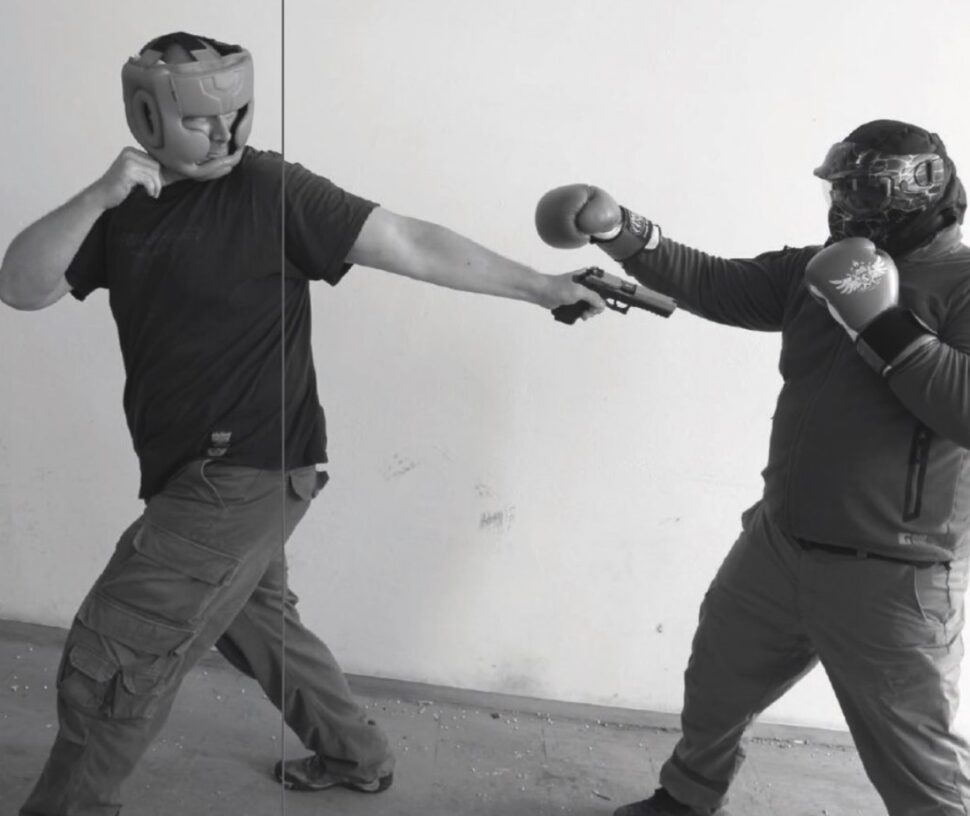
Defense while retreating – use of this principle during defense.
PROCEDURES FOR EFFECTIVE DEFENSE SHOOTING
Shooting procedures within a person’s training have a significant gradient of difficulty. For this reasonit is necessary to realize that for a beginner it is not good to skip or omit any of the methodical sequences. This is true for an advanced shooter as well.
It must be understood that all stages of marksmanship training are important and without mastering them it is impossible to succeed in a self-defense situation. You must be able to use all the basic principles of shooting on the spot, on the move and at a dynamic speed. Remember that shooting does not consist only of aiming at a target.
You need to master three separate areas of shooting for effective defense:
1. aimed shooting,
2. reflex shooting (from the waist, shooting by feel),
3. shooting without aiming - rapidshooting (shooting by pointing).
If you have not drilled and experienced all these essential principles or techniques so that you can execute them without pause while shooting, your gun defense may fail.
It has been my experience that people who are preparing to defend themselves slip from practical defensive shooting to a different shooting style. Sporting, situational, defensive, military or other professional shooting styles incorporate different principles though they comprise similar procedures.
Based on my experience, I divide marksmanship training into five important degrees. Each degree must be mastered before moving to the next degree.
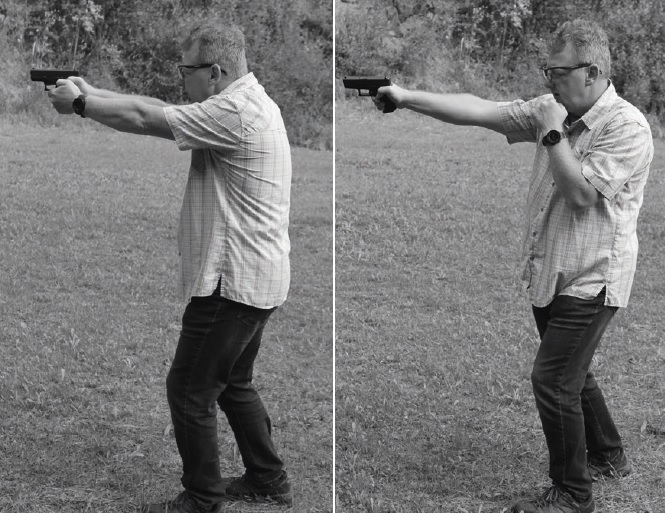
Aimed shooting Shooting without aiming - rapidshooting
Kindergarten (shooting from one position in one direction and safety)
It is necessary for the shooter to master basic safe handling of agun han and shooting at a single target in one direction. This degree also includes cleaning and maintaining the weapon, the action of drawing the weapon from its holster and troubleshooting mis-shots. One must also not forget the legal principles of storing a weapon and securing it against misuse by others.
Primary school (shooting from the ground in different directions at stationary targets)
The second degree involves shooting at various distances. It is either precise or fast dynamic shooting in multiple directions. To this must be added the shooter's ability to handle the weapon with certain speeds (change clips, switch to two-handed shooting and use both one’s strong and weak hand). All of the aforementioned basic principles and drills are performed from one spot. The shooter must also be capable of identifying uninvolved persons in the line of fire. This means thatwhen a shooter is moving in space, they must stand firmly in place when firing in order to properly execute an armed defense. The mark or target remains motionless in one place.
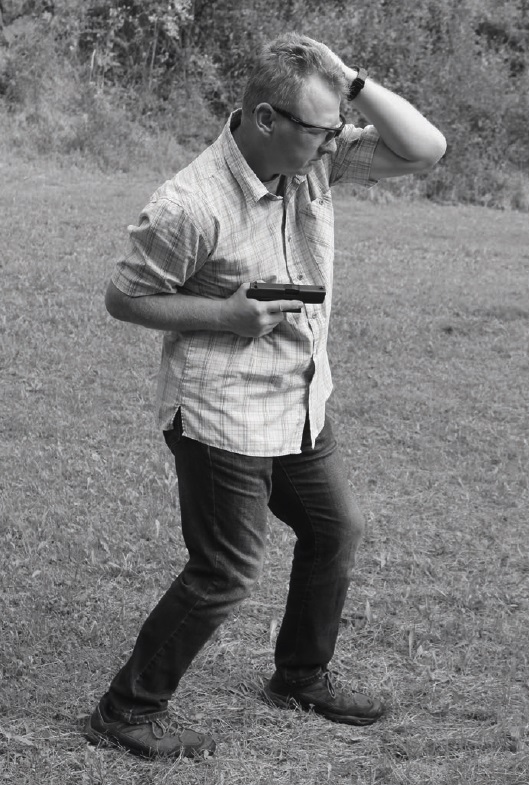
Reflex shooting
High school (shooting in motion in multiple directions upon stationary targets, or shooting from a spot on moving targets)
The shooter carries out defensive shooting in all directions (in the range of 360 degrees) and excellently handles the weapon whilereloading, loading, removing misfires or drawing. They must be able to sense their surroundings, move safely within them and use varied cover. If necessary, they can coordinate with other shooters. The essential difference from the previous two grades is that the shooting is carried out under maximum rapid motion that the shooter is able to exert. They are in motion and the target remains stationary. Or even vice versa, the targets are moving in different directions and speeds while the shooter is standing in one place.
College (shooting in motion in multiple directions upon moving targets in different directions)
The fourth degree is shooting in full 360 degrees, taking into account uninvolved persons located in the shooting range. The shooter is capable of high-level coordination and communication with other shooters. This means that a shooter must assess the situation while only firing at threatening targets. If there are other shooters to assist in a person’s defense, they can effectively coordinate as a group that is defending itself against an aggressive attack. Shooting is done on the move and at moving targets.
Practical school (shooting and fighting against a motivated, thinking attacker or attackers)
This is essentially the stage where all the other levels are merged together and additional attributes are added to the shooting itself. Close combat, personal protection, various tactical or professional procedures, proper movement, spatial awareness, psychological and medical training must be mastered. All of these combine to form combat
self-defense readiness in continuous and long-duration situations that have been simulated in a controlled environment. Self-defense is used againsta person simulating an attack and realistically reacting to the shooter with force, motion, and skill and disposition with the aim to hit the defender.
ATTENTION!
All these exercises that you practice to attaina certain level of shooting skill that I have described can then be trained under pressure, time stress, alternating dynamics or increasing speeds. This is not to say that these exercises are at a higher level but more difficult conditions only serve to improve and deepen the knowledge at any level of shooting.
This is also an area of methodology. How you learn different shooting skills and how you achieve confidence at a given level, the manner of your training, its direction and targeting of the need toincrease yourproficiency determines how quickly and efficiently you reachyour desired level. Initially it depends on the shooting instructor. Only at the end will it be in your hands because it is up to you how you develop your skills.
At the same time, you have to realize the purpose of the direction of your individual training within the level of defensive shooting.
The first level (kindergarten) is mainly focused on skills at the shooting range. It comprises 20% theory and 80% basic gun handling and subsequent shooting practice.
The second level (primary school) is also about skills at the range and contains 30% theory and 70% shooting or gun handling practice.
The third level (high school) is 50% about practicing other skills such as physical training, close combat and medical training. The remaining 50% is dedicated to shooting at the range, while using physical and close combat skills.
The fourth level (college) is 70% concerned with tactical skills, analysis of options and simulations. Only 30% is devoted to shooting at the range, being physically ready, shooting under different lighting conditions and other specific situations such as being injured or dealing with other primary objectives (protection or defense of others).
The fifth level (practical school) is 80% about simulations and psychological training using all the possibilities and different variations in the scenarios. About 20% of it is focused on shooting at the range.
Your training and preparation should be directed towards different types of simulations. Only these will teach you to use what you most need in a real self defense. Through simulation you learn the required reactions. Without this practice you would not know how to do anything properly. Only by practicing through simulations will you learn how to properly adjust your psyche, to react intuitively, and to move and be accurate while shooting.
You also must learn to read body language, use safe precautionary procedures and how to move in different spaces and situations. Basically, practicing complete prevention so that you are capable of noticing what is going on around you and reacting to it fluidly.
Please realize that there are no special or secret techniques to handle and withstand an attack on yourself. There are only well-learned principles and your skills. And not only in the field of shooting. You use these principles and skills when necessary to survive. You adapt them to what is currently happening around you.
It's the only thing that's going to give you a chance to survive...
By going through all these stages via gradual, meaningful and methodical training you will ensure that you will make the right reactions. You will be able to appropriately use any self-defense means and weapon. The sequence of individual steps or levels of training should be maintained. If you are in self-defense training with a weapon to deal with real situations, each of your training sessions should be aimed at fulfilling the principles of defense.
Otherwise, you may slide into a type of police or other professional shooting that while appearing to help you deal with self-defense situations, may just make it harder for you to do so. That is because it focuses on different procedures and advances different evaluation criteria such as the timeliness or accuracy of a hit. These are not as important or effective in protecting yourself in a real self-defense situation.
In a later chapterI will present a mathematically-divided explanation of the possibilities of successful self-defense. If you train with shooting drills that assume that an attack will happen exactly as you imagine it and you will spot it in advance, you are only preparing for 25% of the situations that may occur. This is because you are not training for the possibility that you will not be able to have notice of the attack and will not be able to act in advance. I think that is a big mistake.
GROWTH SPIRAL
The five areas mentioned above are the basis for resolving a self-defense situation that interacts with and determines your growth.
You need to realize that these levels are in a closed circle that repeatedly goes round and round and increases your level in each area. Your abilities will gradually grow.
That is why I call it a growth spiral.
What is it?
It's both very simple and motivating. You start your training for gun defense at the range with the basics, gaining primary skills for efficiency, accuracy,and safe gun handling.
After you make progress it is a good idea to start carrying a gun daily. By doing this, you are both practicing and determiningwhat holster or other accessories work best for you. You will understand any limitations and start to consider making your own improvements in carrying the gun so that it best suits you.
During this process you will also begin to undertake basic precautions like observation and safety awareness of your surroundings, the people and activities around you in your daily life. You will also understand that this is not everything and you will need to work on your physical fitness as well. Fitness and strength training must be added to your program.
But it doesn't stop there. If you want to use a gun for selfdefense, you will understand that you cannot do so without basic self-defense movement skills. The beginning of defense against a close assault is always moving, ducking, and fighting using your body to distract the opponent. Only then follows the draw. This area needs to be well-addressed in training.
Once you have reached a certain level in marksmanship, carrying a weapon, contact combat and physical endurance, you can advance to the next level. This is practical application of these skills in a controlled environment of simulated attacks or assaults. In this wayany deficiencies that need to be corrected will be shown. For example, you may find that you have not practiced one-handed shooting that you will need for close-quarters defense. Also, you may not be fast enough to dodge a knife attack. Alternatively, you may find that if someone knocks you down, you won't have enough strength to get out from under them because you have not practiced the appropriate self-defense skills. You will quickly understand what you need to improve and then you can start to address your deficiencies.
Then you rerun simulations with various other situations, which helps you to identify any other weaknesses. You may need to go back and retrain in an area that you need to practice or improve. It is an iterative process. That's why I call it a growth spiral that never ends.
As you get better at shooting, you must also improve in all other areas at the same time. Without them, you will never grow or be able to cope with increasingly difficult defensive situations. It is important to remember that this is the ideal case. You must motivate and educate yourself. Nothing prepares you better for different defensive situations than simulations that make sense, are uncomplicated and can be set up simply. These simulations motivate you to get better because what you mess up now can be fixed in the future.
You should understand from the beginning that if you are to train yourself and grow in defensive shooting in a meaningful way you must look at it holistically, across the board. However, if you leave out any one area of your training, you are not fully prepared to engage in defensive shooting in its entirety. A big belly and panting when walking has never given anyone an advantage when defending against an aggressive offense - not even if you are carrying two guns and lots of ammo.
The training procedure I describe has one more advantage. It is that during your training you will only be dealing with essential procedures and not some based on assumptions. Simulations will show you clearly and accurately the area where it is really necessary to train.
For example, if you are training for car defense,you will understand if it is better to stay in the car than to get out of it after a few simulated unforeseen attacks Based on your own experience, you will be able to answer the question of whether the car defense procedure you are learning and practicing is the right one. At the same time, you must realize that defensive shooting as such belongs to the third level of shooting skills. If you have not mastered the first and second levels well you should not venture into the third level.
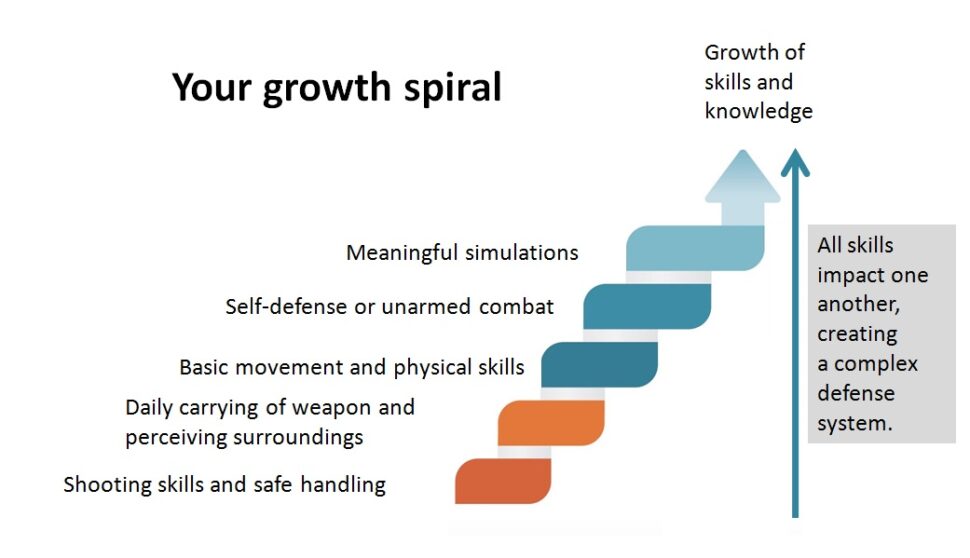
Because errors will manifest themselves very quickly during simulation you will likely need to go back to a lower level and retrain. Otherwise, you are just wasting ammunition if you are not able to hit the target and evaluate your shooting. You are asking for trouble related to safe gun handling. At best, you are firing a lot of random shots in an unhelpful direction orat the wrong time. The safety of such actions is absolutely zero and this is the biggest and most common mistake.
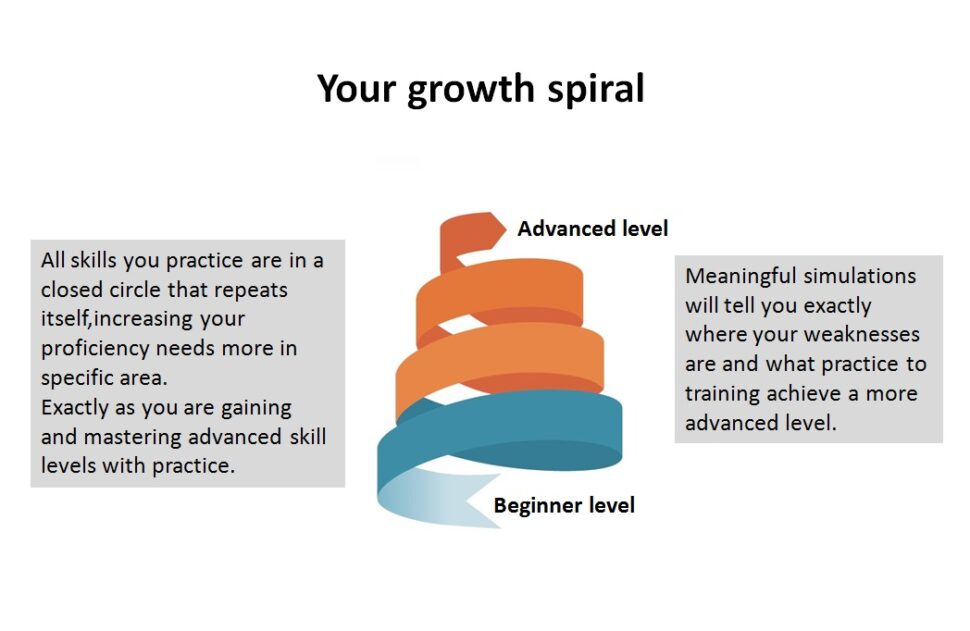
Why does physical training makesense?
It needs to be said right from the start that defensive shooting skills are closely tied to your physical abilities. You must be able to handle fast and dynamic movement. You must be able to withstand the weight and strength of an attacker.
You don't have to sweat for hours in the gym or on the treadmill. You need to master the basic elements of physics. Short distance sprints with change of direction should be a staple. Also, 20 to 30 pushups without a break or 20 squats with a lunge. You need to master the squat, crawl, forward and backward roll. These are the minimum requirements.
If you don't master the movement actions but have learned everything else, YES shooting, you will pay the price for your lack of physical fitness. In a surprise attack, you will not be able to use your body strength to maintain the necessary distance from the attacker while you draw or quickly position yourself behind safe cover.
Why does self-defense play a major role?
An integral part of defensive shooting is hand-to-hand combat or self-defense. You can also call it martial arts. Whatever it is called, the meaning is the same.
The goal is to eliminate an attacker's initial assault, to divert their weapon in another direction, or to otherwise stop it. The important thing to remember here is that you just need to master the basics; you don't need to become an expert. At the same time, you need to train in the skill set that is right for you. You should not choose a martial arts or fighting style based on what you like. You must be guided by your personal characteristics. Are you tall, thin and have little muscle mass? Different movement principles will suit you rather than ones for those who are short and stocky.
I recommend skipping martial arts taught as a sport as too much depends on the coach. My advice is to learn more aggressive fighting styles such as boxing, MMA, Wing Chun or Systemu.
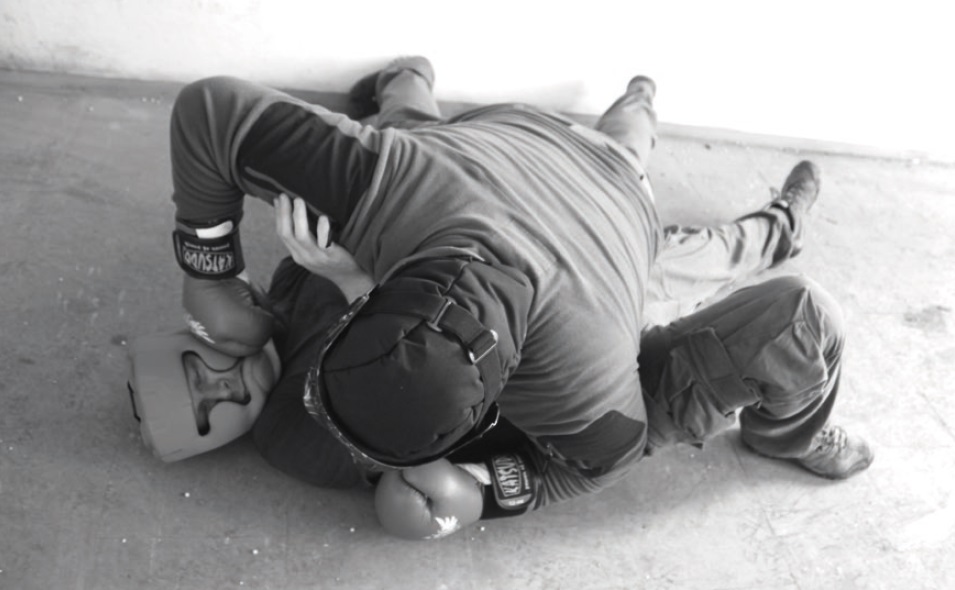
Imagine that you were attacked by a much bigger attacker. Imagine that you were not able to remain standing and the sturdy attacker is lying on you with his full weight. How will you defend yourself? How do you get to your gun? The basics of self-defense or fight while standing or on the ground are necessary.
Aggressive, as in fast, simple and effective
If you want to master defensive shooting, you need to know how to defend yourself against a bare-handed attack using a short and dynamic move, punch or kick. The weapon must become just an accessory that you use to make your defense successful. The actual drawing and use of the weapon are a continuation of your movement in defense or in fighting the attacker under maximum control of safe handling. The weapon, while essential, is not dominant and should in no way be seen as the sole means of protection.
What should one focus on in practice shooting at the range?
The basic skills in defense shooting are developing your body speed, shooting only on the move and shooting one-handed with equal skill in both your strong and weak hand. Shooting is done from the waist with reflex shooting or so-called flying shooting. Wrestling and subsequent use of the weapon is practiced in pairs, including shooting from behind obstacles and clearing - such as searching a housing unit. Various post-wrestling activities inside a car or defending yourself during an attack while sitting in a car must be learned before subsequent use of a weapon.
A very significant difference between training and a real situation is one’s psyche. It is necessary to train your reactions to unexpected stimuli. What you can practice in pairs at a shooting range or somewhere in a gym is only half of the necessary skills and these certainly will not be enough. It is like taking driving lessons and then getting behind the wheel on your own, without an instructor, and taking your first drive around town.
Only subsequent regular practice gave you the reactions, foresight, intuition and skill you could not have learned otherwise.
The same is true with defensive shooting. To get it under your skin, you have to practice.
Even if it's funny to some, I recommend you start playing airsoft.
For some, airsoft combat is playing as soldiers or as a pastime for small children, but for others it is an excellent way to practice reactions, movement and non-standard situations. These require you to think quickly, make decisions, and then react with the use of a weapon. It's an excellent way of putting what you know into practice.
This should be a practice fight against an equally motivated, armed and thinking opponent. This kind of training will have the greatest practical effect for you.
Of course, it is necessary to think about the details because some little things connected with airsoft gun design are not realistic and sensible compared with shooting live ammunition with a real gun.
At the same time, be aware that airsoft has precise rules that are notacceptable in a real-life situation. For example, in the event of an airsoft hit, acknowledgingit and ceasing further activity is required. In reality, you must continue to defend yourself at all costs despite any injury.
Therefore, whatever you do as a supplement to defensive shooting, never underestimate practice combat.
ABOUT PATRIK
Patrik Žitník is a military professional providing specialized training for the civilian sector through ARMY TRAINING Ltd.
He is also a lecturer and trainer in the field of survival, shooting, tactics, diving, climbing, safety and methodical procedures for various levels of training and their complexities.
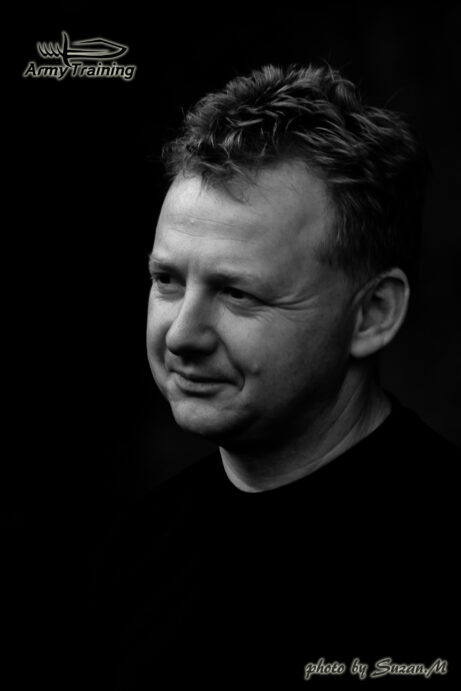
He has been involved with various areas of the military since he was thirteen years old when he enrolled in his first military school with programsranging from youth defense exercises to training of members of military and police special forces.
Later, based on his results in combat sports and his excellent professional skills, he joined the airborne troops, where he graduated from the Department of Reconnaissance and Military Intelligence. [Training Command - Military Academy - Vyškov]
After graduating from college, he was assigned to a deep reconnaissance company in Bratislavawhere he and his group achieved excellent results in training and in international competitions. He and his fellow paratroopers three-times won an international competition of reconnaissance patrols in Austria, called Österreich-Patrouille.
Based on his achievements he received awards from the President of the Slovak Republic, Michal Kovac, from the Chief of the General Staff of the Armed Forces of the Slovak Republic and others.
In 2000, he became a laureate of the 4th annual Military Act of the Year for his. He was awarded for the rescue of a student of the PolishArmy while crossing the Low Tatra mountains during a military exercise.
Patrik devoted his entire free time to training, methodology and education in various areas necessary for defense and security and the proper manner of training individuals and groups.
Because he was already a close combat instructor for the Slovak Armed Forces achieving good results, Patrik was approached to transfer to a military training facility to develop specialized training to educate soldiers and specialists in areas such as survival, diving, special training, shooting and military climbing.
During more than eleven years as an instructor at the Institute of Special Health and Training of the Ministry of Defense in Lestand later as Director of Special Training, he attended numerous specialized courses in Slovakia and abroad. Some examples are a one-month winter survival course in the Slovenian Alps, a MILES course in Germany, an Israeli course in personal protection and defensive shooting, courses on close combat and high-mountain climbing skills.
More than 4,000 people in the military have attended his specialized and professional courses. Current and formergenerals and other high officials were among them. Patrik has also trained new instructors on various techniques for successful training. He has also trained journalists leaving to prepare for filming their reports in danger zones abroad. Additionally he drafted procedures and methodologies for training and introducing new elements into the Slovak Armed Forces. He has educated individuals, groups of specialists and leaders in these fields.
At the end of his military career, he helped in the development of specialized training facilities for the Slovak Armed Forces at its Lest location, which was later renamed the Lest Training Center.
In addition to conducting training for individuals, he works closely with several companies in training their corporate leaders or conducting specialized outdoor training.
Currently, he is helping anyone who is interested in learning how to: survive in various conditions, react quickly in crisis situations and effectively use a weapon for self-defense.
Patrik:
- served more than 20 years in the armed forces, eleven of which as an instructor or chief instructor, training and methodology supervisor,
- graduated from numerous shooting and tactical courses at home and abroad, focused on police and military skills and tactics,
- authored a system of defense shooting under the name of ISDS (Individual Self-Defense Shooting System).
Information included in the book HOW TO TRAIN DEFENSIVE SHOOTING is consistent with the legislation of the Slovak Republic, which clearly stipulates the conditions under which an ordinary citizen may carry a weapon for their own protection and the conditions under which such weaponmay be used.
Pursuant to applicable Slovak law:
- an ordinary citizen may carry a weapon only in concealed carry and only after having obtained a firearm license,
- the license can be obtained after meeting specifiedconditions (psychological tests, medical examination, professional testing),
- the weapon may only be used in case of “necessary defense”, when someone is repelling an attack upon their person, health, or property, and against an attack in progress, or an attack that is imminent; any defense that was clearly disproportionate to the attack, its form, place, or timeis not considered “necessary defense”,
- the weapon may also be used in case of “extreme distress”, during which danger directly threatening a person, their health, or property is being repelled; a situation is not one of an “extreme distress” if it was possible to avert the imminent danger by other means or if the inflicted consequences of defense are clearly more serious than those imminent from the attack.
For more details, see the Criminal Code of the Slovak Republic.
"Learning and self-improvement is an inherent
part of life. I enjoy training and passing on
my knowledge to others. I regularly
improve myself through other courses
in areas that interest me. Annually
I attend about five to eight seminars or courses
with other specialists..."
Patrik
CONTENTS
- About Patrik
- Introduction
- Gun at home?
- Two important thoughts essential for understanding gun defense
- A little statistics to understand the problem of defensive shooting
- Prevention, observation, safety perception
- Phases of attacks and their categorization
- Direction of attack
- Distance
- Moment of surprise
- Weapons used
- Why is it necessary to know different approaches to training?
- Psychology of defense
- Decision-making during defense
- Defense or fight?
- How to react?
- All you should know if you want to carry a gun daily
- Exposing the biggest enemies of defense shooting
- Procedures for effective defense shooting
- Which principles of defensive shooting do I prefer?
- How to start with training of defensive shooting?
- What is the most common mistake?
- What should be the drill?
- Growth spiral
- Why does physical training make so much sense?
- Why does self-defense make such a great sense?
- So, what to focus on during practice at the shooting range?
- Impact of surrounding space on defense
- How to act during defense in open space?
- Basic rules for defense in open space
- How to act during defense in apartments, house, or office?
- Rules you must remember in closed spaces
- Which principles are important to be added to your existing skills?
- Shooting from behind a barricade
- How to solve a stalemate situation?
- What should you know in order to execute offensive techniques in CQB space?
- Shooting with a rebound
- How to proceed while defending in a forest or park?
- How to proceed while defending in a car?
- Understand what kind of protection a car really gives
- Why are these techniques taught?
- What is the accuracy of shooting from a car or through it?
- What is actually happening during defense in a car, when the fire goes from or to the car?
- Clearance of the car
- How to do defense in a car?
- How to proceed while defending in a street?
- Principles of defense with light
- Flashlight
- Training simulation in defensive shooting
- Purpose-built simulation
- What weapon is suitable for daily carrying?
- Gun caliber
- Ammo capacity
- What holster to use for daily gun carrying?
- What to have with you during daily carrying?
- Shooting basics that lead to your effectiveness
- Posture
- Holding of the gun
- Breathing
- Aiming
- Triggering
- Gun disassembly
- Drawing rule
- Shooting on the move
- Safe handling
- Conscious shooting
- Finger off the trigger
- Understanding the gun status
- At a shooting range, when is the gun loaded and when not?
- Safe waiting positions
- Loading
- Unloading
- Magazine load and release
- Practical exercises for improvement of gun defense effectiveness
- Methodology: what to do, how, and why?
- My methodological rules
- Motivation needed for gun defense training
- How to save money during training?
- Conclusion
Acknowledgments
- Annex 1 – test of holsters for defensive shooting
- Annex 2 – principles of ISDS gun defense
- Annex 3 – my training – basic shooting exercises for every day
- Annex 4 – defense in a car and behind it


- Number of pages: 232
- Year of publication: December 2020
- Language: Slovak
- Publisher: ArmyTraining
- ISBN: 978-80-570-2422-4
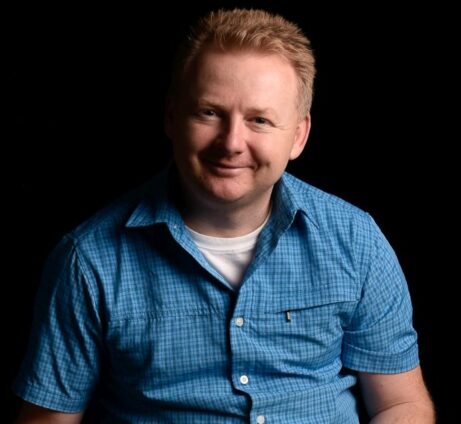
Ing. Patrik Žitník
Did you like the sample?
Would you like to support the publication of this book?
If you are interested to donate 3 – 5 € to professional translation, editing, design, and printing of this book, please do so to my account.
In addition, if you enter your e-mail address in the message for recipient field, you will receive information about its publication and will be offered a special, discounted price!
Account name: Ing. Patrik Žitník
Variable symbol: 2021
IBAN: SK02 8360 5207 0042 0408 7126
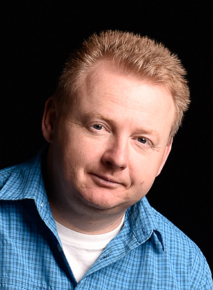
Do you want to write to me?
Ing. Patrik Žitník
E-mail: patrik.zitnik@gmail.com
ARMYTRAINING.SK ©2015

